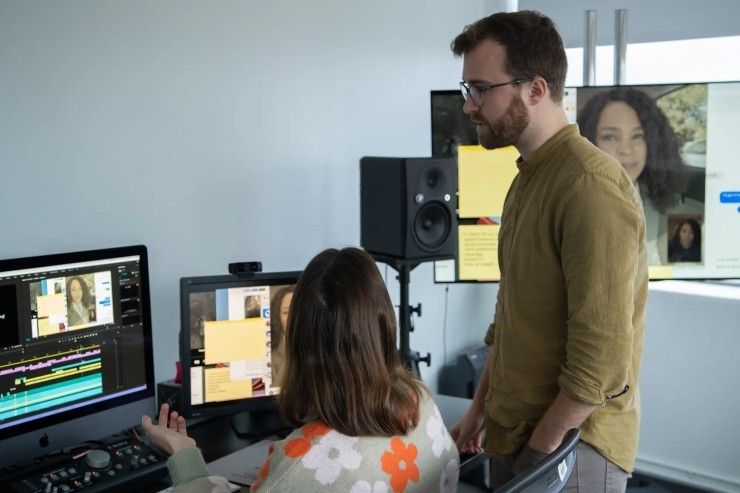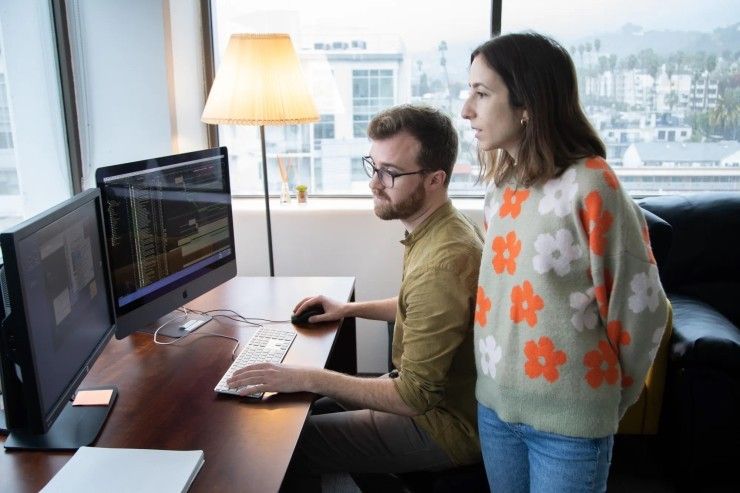
In 2018, Searching introduced audiences everywhere to the screen life genre — where stories unfold entirely on screens, from computers to cellphones to smartwatches, security cameras, and more. Now, the creators of Searching have delivered a new edge-of-your-seat mystery in its sequel Missing, proving once again that the digital world makes for compelling filmmaking.
This post was written by Meagan Keane and originally appeared on Adobe blog on Feb. 2, 2023.
To bring their clever computer-screen thriller to life, the filmmakers turned to Adobe Creative Cloud.
Written and directed by Nick Johnson and Will Merrick, Missing blends a star-studded cast with technological triumphs to captivate the viewer. When Grace — played by Nia Long — disappears while on vacation in Colombia with a new boyfriend, her teenage daughter June — portrayed by Storm Reid — turns to the internet in her search for answers. Stuck thousands of miles away in Los Angeles, June uses the latest technology to find her mom before it’s too late.
Like June, the filmmakers relied on innovative tech to craft a tale told entirely through digital devices.
“Making a screen-life film required us to edit, build shots, and design thousands of graphics simultaneously,” said editors Arielle Zakowski and Austin Keeling. “We needed tools that were fast, flexible, and collaborative. Without Premiere Pro, After Effects, Frame.io, and the entire Adobe Creative Cloud, this film would not exist.”
Zakowski and Keeling’s workflow took full advantage of the interoperability of Adobe Creative Cloud software. The editors mocked up graphics with Photoshop and Illustrator, before dynamically linking the content over to After Effects for final assembly. While cutting the film in Premiere Pro, the editorial team relied on the tool’s most popular features — from Motion Graphics templates to the Sensei-powered Morph Cut — to bring each element on screen to life. The pair also used Productions in Premiere Pro to remotely collaborate with each other and the film’s assistant editors, while turning to Frame.io’s cloud-based review and approvals platform to garner feedback from directors, producers, and studio team at Sony Pictures.
Missing, now playing in theaters nationwide, tells an equally fascinating story behind-the-scenes as it does on screen. Read on to hear more from editors Zakowski and Keeling about how they created the new gripping screenlife film.
How and where did you first learn to edit?
Keeling: I found my family’s old video camera when I was 11 or 12 and quickly started experimenting with making little short films. I fell in love with the process, especially bringing the final project to life through editing. I taught myself how to edit when I was young and transitioned to Premiere Pro when I started high school. I’ve stuck with Premiere ever since!
Zakowski: I’m pretty sure the first thing I ever edited was a video I made for my sister’s Bat Mitzvah when I was in high school. That might have actually been the first moment when I realized I liked editing, though I doubt I really knew what editing was! Then when I was 18, I interned at a tiny editing company where they essentially left me in a room with a computer, and I taught myself how to use the editing software.
How do you begin a project and set up your workspace?
We started working on this film during the height of the pandemic, so we were editing from the familiarity of our homes. Once production wrapped we transitioned to an office, bringing with us some personal touches (photos of cats, oil diffusers, notebooks, etc.) to make the often-bare editing rooms a little cozier. We were working in rooms next door to each other, so we each imported our own keyboard shortcuts, set up the window layouts the way we liked, and plugged in our mouse (for Austin) and Wacom tablet (for Arielle). Within a matter of minutes, we were ready to keep working away!
Check out this BTS footage from @sonypictures #missingmovie – out now and made in @AdobeVideo! | #PremierePro https://t.co/NXugJzCiX9 pic.twitter.com/UTXJtm6F8u
— Adobe Video & Motion (@AdobeVideo) January 24, 2023
Tell us about a favorite scene or moment from this project and why it stands out to you.
This whole project stands out because it was so different from anything else we’d ever done. A lot of our favorite scenes to work on were the ones that pushed beyond the craft of “traditional” editing. There’s one scene in particular toward the end of the film that is told entirely through screen elements with no live footage of the characters and no lines spoken at all. This was a really fun challenge for us to create the tension and suspense from scratch, using only the animation of the mouse, the pacing of the shots, and choices with our in-screen “camera” to determine how the scene unfolded.
What were some specific post-production challenges you faced that were unique to your project? How did you go about solving them?
Because the whole film is told through computer and phone screens, this project posed a ton of post-production challenges from the very beginning. None of the film is screen-recorded — we needed the freedom to alter each app, web page, and mouse movement to fit our needs, so we had to recreate every element seen on screen. This allowed us to make creative and storytelling changes down to the pixel level and ensure that every frame is true-to-life and genuinely “pause-proof.” Figuring out the workflow and juggling such a huge array of assets was a massive puzzle, but we really think it pays off in the finished film!
Credit: Sony Pictures Publicity
What Adobe tools did you use on this project and why did you originally choose them? Why were they the best choice for this project?
The real question is, which Adobe tools didn’t we use?! We started our editing process in Premiere Pro, taking screenshots of apps on our computer and bringing them into Photoshop to modify them as needed for the scene. We used Productions which made it so easy to share sequences back and forth with each other and for our Assistant Editors to send us media or access our timelines instantly.
As we got close to picture locking, we used Illustrator to build all of our graphics from scratch, creating vectorized assets that would remain crystal clear no matter how much we needed to zoom in on them. Once we were locked, we dynamic linked each scene over to After Effects, where we replaced the temp graphics with the hi-res ones, relinked the offline footage to the graded video, and added a crazy amount of detail to each shot – things like handheld camera shake, blurring and vignetting, and motion sketching every single mouse move to give it a lifelike, organic feel. We rendered DPX sequences right out of After Effects to assemble the final movie. Missing honestly couldn’t exist without the use of Creative Cloud’s tools, so it was our #1 (and only) choice from day 1.
We also used Frame.io throughout the entire process. While we were working from home during the pandemic, we would upload our work-in-progress edits to the directors almost every day. They would review them and often leave notes directly in Frame.io for us to execute the next day. Once we were all working together in the office, we used Frame.io to send cuts of scenes and/or the entire film to producers and the studio. Frame.io is great for shuttling large files, so our Assistant Editors also used it to upload tons of assets when it was time to work with our graphics vendors and sound teams.

Credit: Arielle Zakowski
What do you like about Premiere Pro, and/or any of the other tools you used?
Premiere Pro especially allowed us to move quickly during the edit. Many of our scenes consisted of 40+ layers of graphical elements, so being able to intuitively navigate through that madness was a huge help.
We used adjustment layers with transform effects to create each of the “shots” in the movie, and we were able to edit changes rapidly and without issue. We used MOGRTs (Motion Graphics templates) to mock out all the typing in Premiere Pro, which let us control the timing and speed to communicate what the characters are feeling. We also had to rough out a lot of temp split screens and VFX shots during the edit, and Premiere Pro’s tools allowed us to seamlessly incorporate these elements.
What’s your hidden gem/favorite workflow tip in Adobe Creative Cloud?
We used so many aspects of so many different Adobe programs, it’s hard to pinpoint just one! That said, using the Proxy Workflow was amazing, as it allowed us to toggle between our proxies and the raw material with the click of a button. This not only helped us keep an eye on the resolution of our footage when we were doing some extreme punch-ins during the edit, but also made our lives much easier when it came time to online all the footage for finishing in After Effects (especially since we were the ones onlining the film!). Premiere Productions was also our MVP because of how easy it made sharing sequences and media between our entire post team.

Credit: Arielle Zakowski
Who is your creative inspiration and why?
Each other! Just kidding. On this project we have to give it to Nick Johnson and Will Merrick, who directed Missing but were the editors of the first film, Searching. They were the ones who essentially invented this workflow on the first movie and were our guiding lights on this project. Both of them were incredibly patient with us as we learned the ropes on this film and were always happy to share their massive wealth of knowledge with the team. Forever grateful to be the editors’ editors!
What’s the toughest thing you’ve had to face in your career and how did you overcome it? What advice do you have for aspiring filmmakers or content creators?
Transitions are always a really difficult moment in this industry, whether that’s a transition from assistant editor to editor, from documentary to narrative, or from indie to studio film. There’s often a moment of internal doubt as you wonder if you can really do it, combined with an external pressure to prove to everyone that you can. We’ve both had moments like this throughout our careers and probably will continue to, but going into the office each day, sitting down at the computer, and keeping yourself focused on the work itself often helps silence the mental noise and reminds us that we love doing what we do. It’s all about knowing your worth and not allowing the inner saboteur to keep you from putting yourself out there.

Credit: Arielle Zakowski
Share a photo of where you work. What’s your favorite thing about your workspace and why?
We had a really nice view of Los Angeles from our offices, and lots of big windows (especially in the corner office that we were lucky to get). A lot of editing happens in dark little rooms, so getting to work in these spacious rooms (with a reminder that there was an outside world just beyond the window) was a real treat! #EditorsDeserveWindows.














